Energy Resources and Regulations: Demand, Generation, Reduction
VerifiedAdded on 2023/06/13
|12
|2970
|285
Essay
AI Summary
This essay discusses strategies employed in the UK to ensure energy efficiency, focusing on demand size response (DSR), distributed generation, and demand reduction. DSR balances energy demand and supply by incentivizing consumers to shift electricity use during peak times. Distributed generation involves technologies like solar panels and wind turbines to supply power locally, reducing transmission costs. Demand reduction programs coordinate with electricity suppliers to lower energy consumption. The essay analyzes the key drivers and barriers to implementing each strategy, including cost reduction, environmental concerns, regulatory challenges, and lack of awareness. It highlights the importance of these strategies in achieving energy efficiency and sustainability in the UK.

Name
Course
Lecturer
Date
1
Course
Lecturer
Date
1
Paraphrase This Document
Need a fresh take? Get an instant paraphrase of this document with our AI Paraphraser
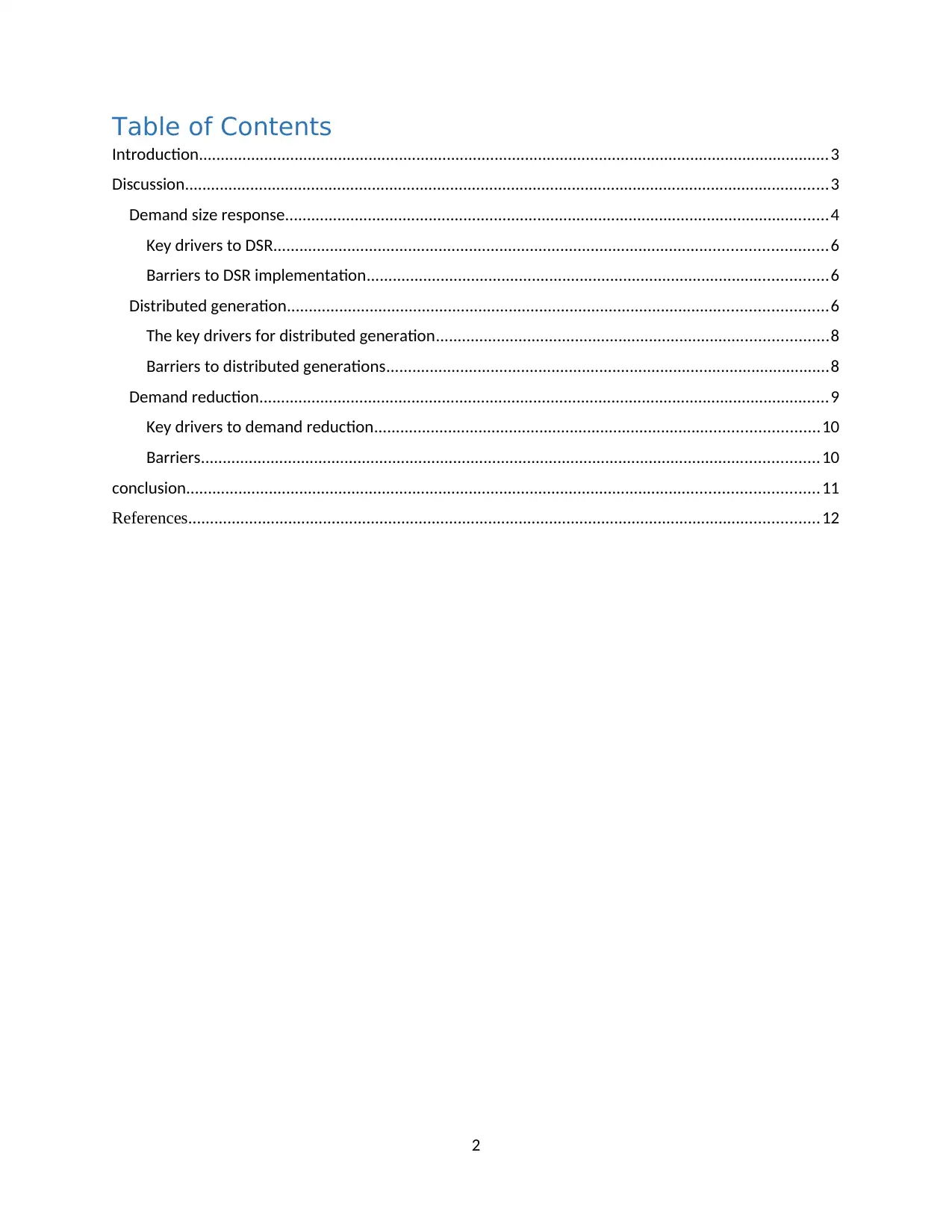
Table of Contents
Introduction.................................................................................................................................................3
Discussion....................................................................................................................................................3
Demand size response.............................................................................................................................4
Key drivers to DSR...............................................................................................................................6
Barriers to DSR implementation..........................................................................................................6
Distributed generation............................................................................................................................6
The key drivers for distributed generation..........................................................................................8
Barriers to distributed generations......................................................................................................8
Demand reduction...................................................................................................................................9
Key drivers to demand reduction......................................................................................................10
Barriers..............................................................................................................................................10
conclusion.................................................................................................................................................11
References.................................................................................................................................................12
2
Introduction.................................................................................................................................................3
Discussion....................................................................................................................................................3
Demand size response.............................................................................................................................4
Key drivers to DSR...............................................................................................................................6
Barriers to DSR implementation..........................................................................................................6
Distributed generation............................................................................................................................6
The key drivers for distributed generation..........................................................................................8
Barriers to distributed generations......................................................................................................8
Demand reduction...................................................................................................................................9
Key drivers to demand reduction......................................................................................................10
Barriers..............................................................................................................................................10
conclusion.................................................................................................................................................11
References.................................................................................................................................................12
2
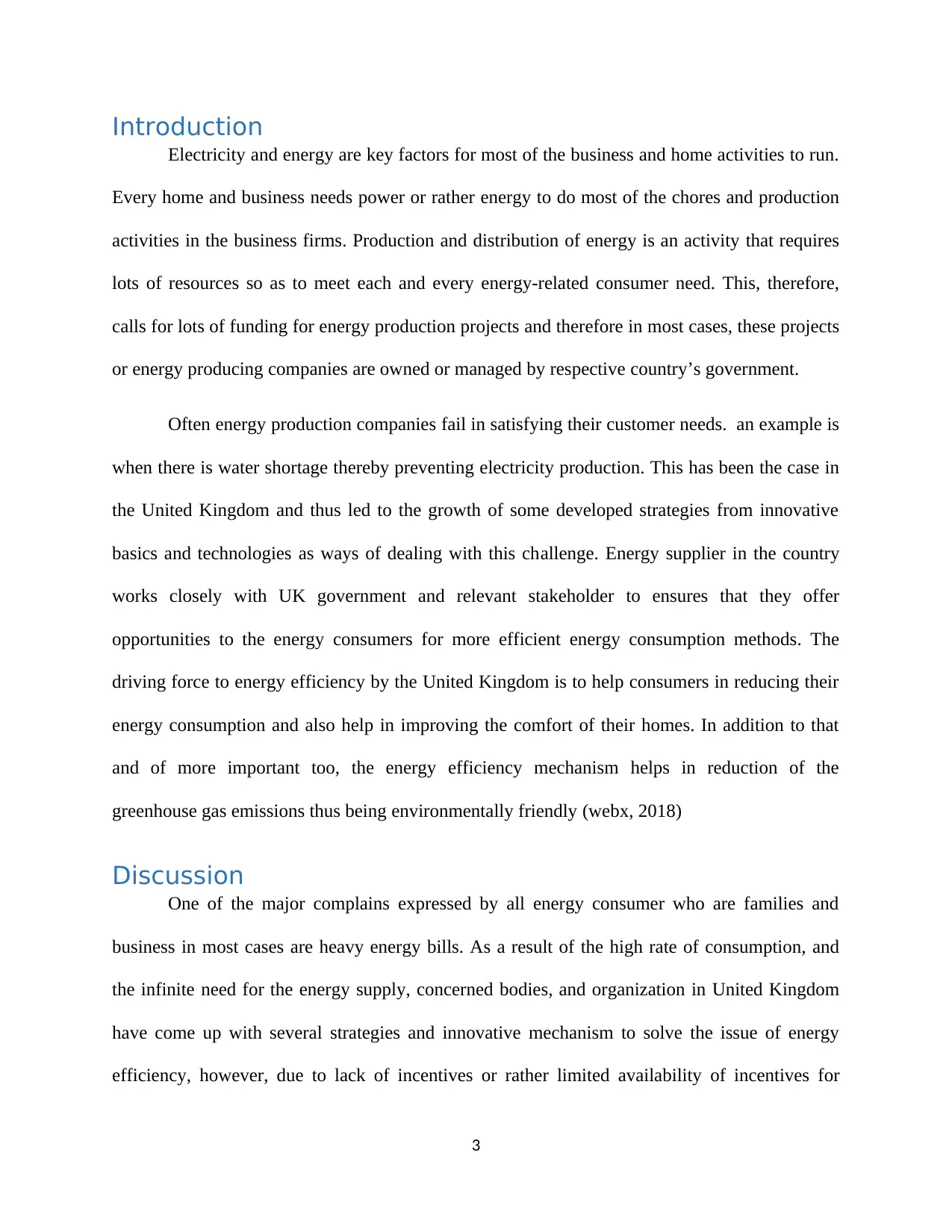
Introduction
Electricity and energy are key factors for most of the business and home activities to run.
Every home and business needs power or rather energy to do most of the chores and production
activities in the business firms. Production and distribution of energy is an activity that requires
lots of resources so as to meet each and every energy-related consumer need. This, therefore,
calls for lots of funding for energy production projects and therefore in most cases, these projects
or energy producing companies are owned or managed by respective country’s government.
Often energy production companies fail in satisfying their customer needs. an example is
when there is water shortage thereby preventing electricity production. This has been the case in
the United Kingdom and thus led to the growth of some developed strategies from innovative
basics and technologies as ways of dealing with this challenge. Energy supplier in the country
works closely with UK government and relevant stakeholder to ensures that they offer
opportunities to the energy consumers for more efficient energy consumption methods. The
driving force to energy efficiency by the United Kingdom is to help consumers in reducing their
energy consumption and also help in improving the comfort of their homes. In addition to that
and of more important too, the energy efficiency mechanism helps in reduction of the
greenhouse gas emissions thus being environmentally friendly (webx, 2018)
Discussion
One of the major complains expressed by all energy consumer who are families and
business in most cases are heavy energy bills. As a result of the high rate of consumption, and
the infinite need for the energy supply, concerned bodies, and organization in United Kingdom
have come up with several strategies and innovative mechanism to solve the issue of energy
efficiency, however, due to lack of incentives or rather limited availability of incentives for
3
Electricity and energy are key factors for most of the business and home activities to run.
Every home and business needs power or rather energy to do most of the chores and production
activities in the business firms. Production and distribution of energy is an activity that requires
lots of resources so as to meet each and every energy-related consumer need. This, therefore,
calls for lots of funding for energy production projects and therefore in most cases, these projects
or energy producing companies are owned or managed by respective country’s government.
Often energy production companies fail in satisfying their customer needs. an example is
when there is water shortage thereby preventing electricity production. This has been the case in
the United Kingdom and thus led to the growth of some developed strategies from innovative
basics and technologies as ways of dealing with this challenge. Energy supplier in the country
works closely with UK government and relevant stakeholder to ensures that they offer
opportunities to the energy consumers for more efficient energy consumption methods. The
driving force to energy efficiency by the United Kingdom is to help consumers in reducing their
energy consumption and also help in improving the comfort of their homes. In addition to that
and of more important too, the energy efficiency mechanism helps in reduction of the
greenhouse gas emissions thus being environmentally friendly (webx, 2018)
Discussion
One of the major complains expressed by all energy consumer who are families and
business in most cases are heavy energy bills. As a result of the high rate of consumption, and
the infinite need for the energy supply, concerned bodies, and organization in United Kingdom
have come up with several strategies and innovative mechanism to solve the issue of energy
efficiency, however, due to lack of incentives or rather limited availability of incentives for
3
⊘ This is a preview!⊘
Do you want full access?
Subscribe today to unlock all pages.

Trusted by 1+ million students worldwide
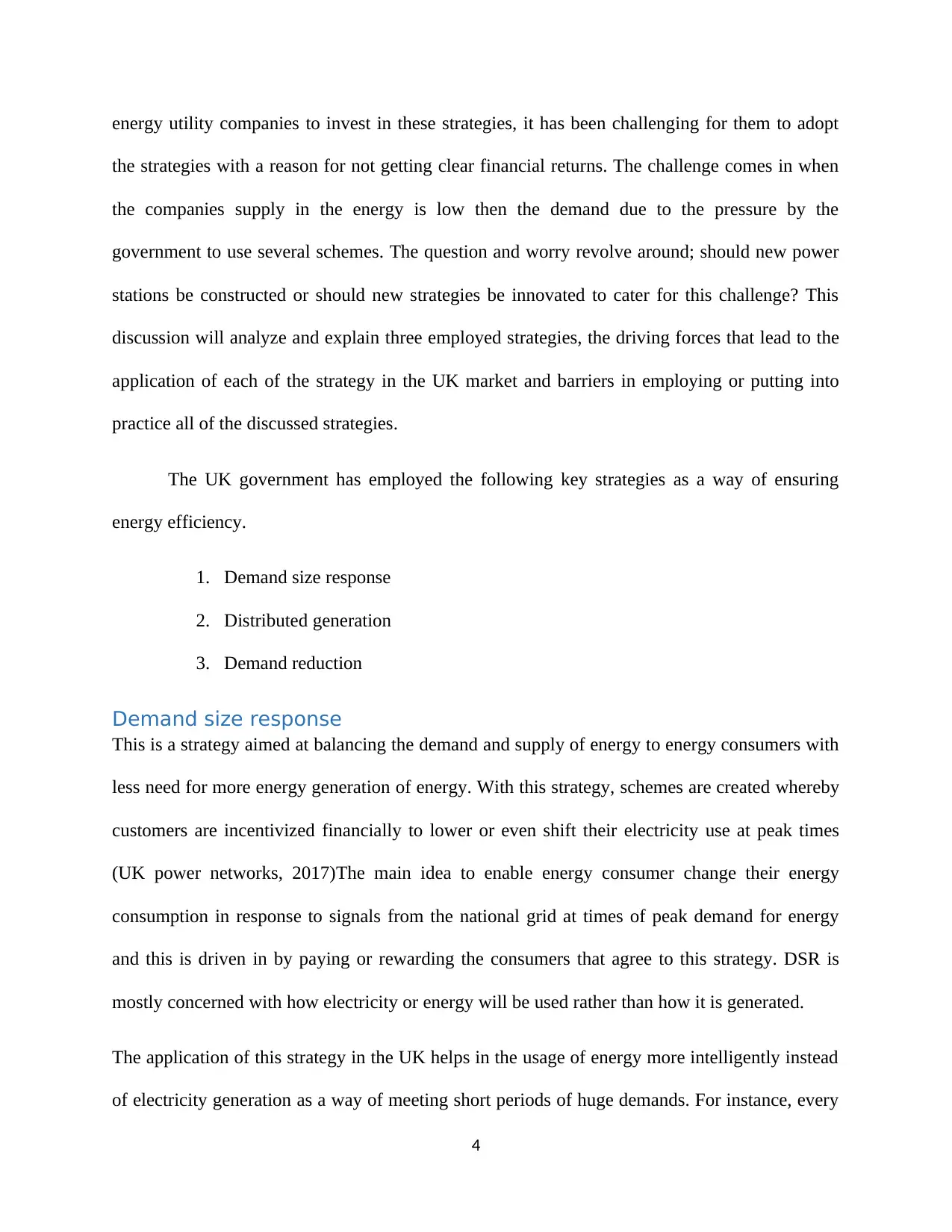
energy utility companies to invest in these strategies, it has been challenging for them to adopt
the strategies with a reason for not getting clear financial returns. The challenge comes in when
the companies supply in the energy is low then the demand due to the pressure by the
government to use several schemes. The question and worry revolve around; should new power
stations be constructed or should new strategies be innovated to cater for this challenge? This
discussion will analyze and explain three employed strategies, the driving forces that lead to the
application of each of the strategy in the UK market and barriers in employing or putting into
practice all of the discussed strategies.
The UK government has employed the following key strategies as a way of ensuring
energy efficiency.
1. Demand size response
2. Distributed generation
3. Demand reduction
Demand size response
This is a strategy aimed at balancing the demand and supply of energy to energy consumers with
less need for more energy generation of energy. With this strategy, schemes are created whereby
customers are incentivized financially to lower or even shift their electricity use at peak times
(UK power networks, 2017)The main idea to enable energy consumer change their energy
consumption in response to signals from the national grid at times of peak demand for energy
and this is driven in by paying or rewarding the consumers that agree to this strategy. DSR is
mostly concerned with how electricity or energy will be used rather than how it is generated.
The application of this strategy in the UK helps in the usage of energy more intelligently instead
of electricity generation as a way of meeting short periods of huge demands. For instance, every
4
the strategies with a reason for not getting clear financial returns. The challenge comes in when
the companies supply in the energy is low then the demand due to the pressure by the
government to use several schemes. The question and worry revolve around; should new power
stations be constructed or should new strategies be innovated to cater for this challenge? This
discussion will analyze and explain three employed strategies, the driving forces that lead to the
application of each of the strategy in the UK market and barriers in employing or putting into
practice all of the discussed strategies.
The UK government has employed the following key strategies as a way of ensuring
energy efficiency.
1. Demand size response
2. Distributed generation
3. Demand reduction
Demand size response
This is a strategy aimed at balancing the demand and supply of energy to energy consumers with
less need for more energy generation of energy. With this strategy, schemes are created whereby
customers are incentivized financially to lower or even shift their electricity use at peak times
(UK power networks, 2017)The main idea to enable energy consumer change their energy
consumption in response to signals from the national grid at times of peak demand for energy
and this is driven in by paying or rewarding the consumers that agree to this strategy. DSR is
mostly concerned with how electricity or energy will be used rather than how it is generated.
The application of this strategy in the UK helps in the usage of energy more intelligently instead
of electricity generation as a way of meeting short periods of huge demands. For instance, every
4
Paraphrase This Document
Need a fresh take? Get an instant paraphrase of this document with our AI Paraphraser
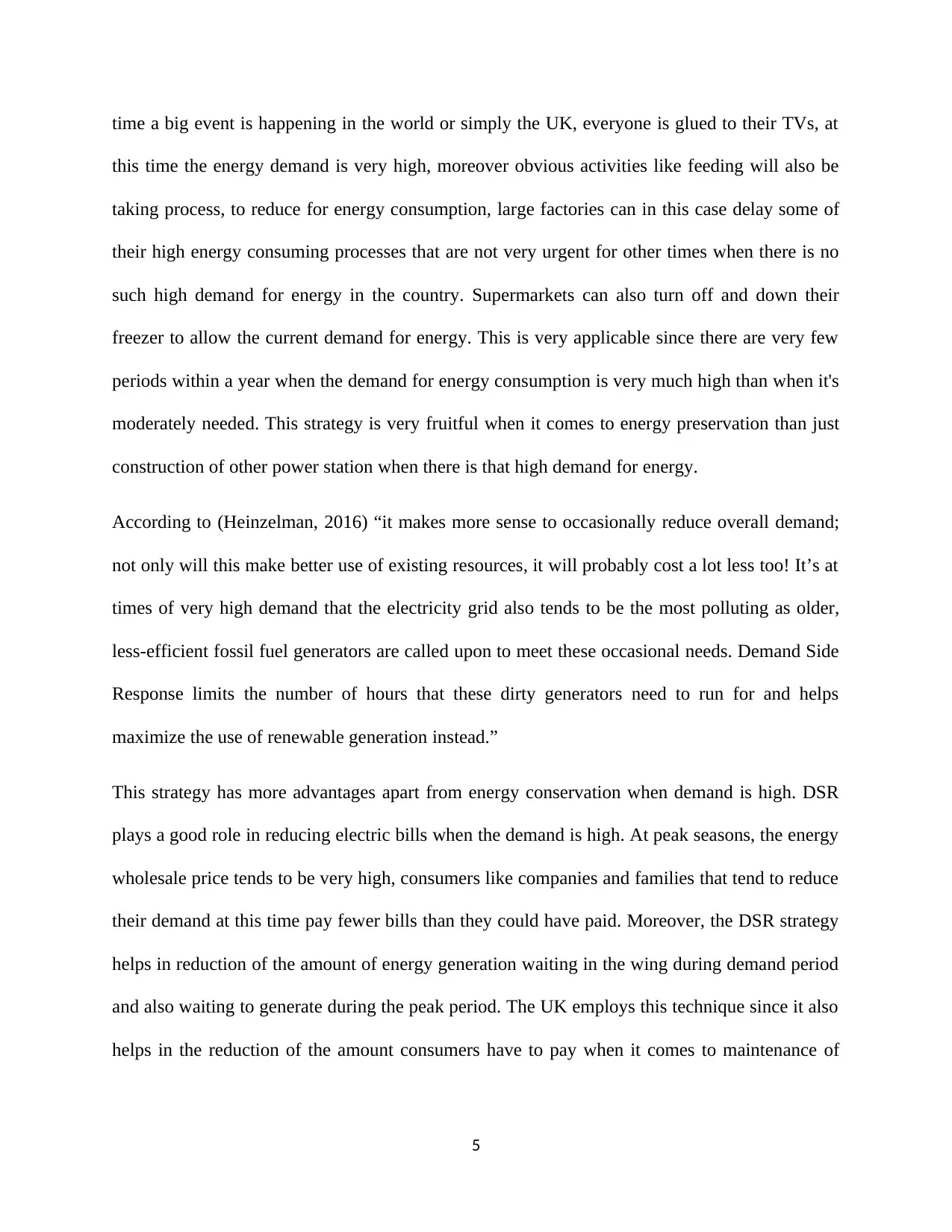
time a big event is happening in the world or simply the UK, everyone is glued to their TVs, at
this time the energy demand is very high, moreover obvious activities like feeding will also be
taking process, to reduce for energy consumption, large factories can in this case delay some of
their high energy consuming processes that are not very urgent for other times when there is no
such high demand for energy in the country. Supermarkets can also turn off and down their
freezer to allow the current demand for energy. This is very applicable since there are very few
periods within a year when the demand for energy consumption is very much high than when it's
moderately needed. This strategy is very fruitful when it comes to energy preservation than just
construction of other power station when there is that high demand for energy.
According to (Heinzelman, 2016) “it makes more sense to occasionally reduce overall demand;
not only will this make better use of existing resources, it will probably cost a lot less too! It’s at
times of very high demand that the electricity grid also tends to be the most polluting as older,
less-efficient fossil fuel generators are called upon to meet these occasional needs. Demand Side
Response limits the number of hours that these dirty generators need to run for and helps
maximize the use of renewable generation instead.”
This strategy has more advantages apart from energy conservation when demand is high. DSR
plays a good role in reducing electric bills when the demand is high. At peak seasons, the energy
wholesale price tends to be very high, consumers like companies and families that tend to reduce
their demand at this time pay fewer bills than they could have paid. Moreover, the DSR strategy
helps in reduction of the amount of energy generation waiting in the wing during demand period
and also waiting to generate during the peak period. The UK employs this technique since it also
helps in the reduction of the amount consumers have to pay when it comes to maintenance of
5
this time the energy demand is very high, moreover obvious activities like feeding will also be
taking process, to reduce for energy consumption, large factories can in this case delay some of
their high energy consuming processes that are not very urgent for other times when there is no
such high demand for energy in the country. Supermarkets can also turn off and down their
freezer to allow the current demand for energy. This is very applicable since there are very few
periods within a year when the demand for energy consumption is very much high than when it's
moderately needed. This strategy is very fruitful when it comes to energy preservation than just
construction of other power station when there is that high demand for energy.
According to (Heinzelman, 2016) “it makes more sense to occasionally reduce overall demand;
not only will this make better use of existing resources, it will probably cost a lot less too! It’s at
times of very high demand that the electricity grid also tends to be the most polluting as older,
less-efficient fossil fuel generators are called upon to meet these occasional needs. Demand Side
Response limits the number of hours that these dirty generators need to run for and helps
maximize the use of renewable generation instead.”
This strategy has more advantages apart from energy conservation when demand is high. DSR
plays a good role in reducing electric bills when the demand is high. At peak seasons, the energy
wholesale price tends to be very high, consumers like companies and families that tend to reduce
their demand at this time pay fewer bills than they could have paid. Moreover, the DSR strategy
helps in reduction of the amount of energy generation waiting in the wing during demand period
and also waiting to generate during the peak period. The UK employs this technique since it also
helps in the reduction of the amount consumers have to pay when it comes to maintenance of
5
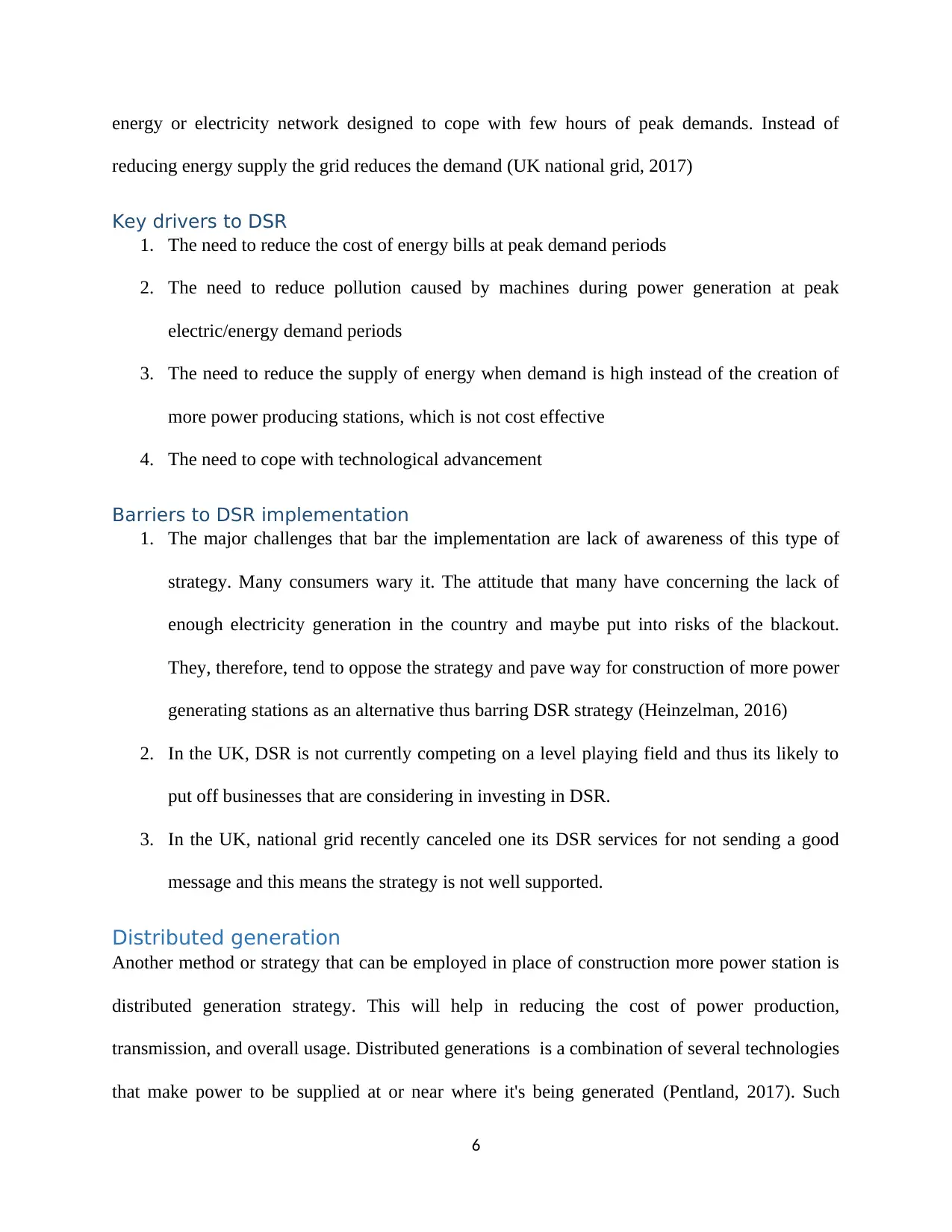
energy or electricity network designed to cope with few hours of peak demands. Instead of
reducing energy supply the grid reduces the demand (UK national grid, 2017)
Key drivers to DSR
1. The need to reduce the cost of energy bills at peak demand periods
2. The need to reduce pollution caused by machines during power generation at peak
electric/energy demand periods
3. The need to reduce the supply of energy when demand is high instead of the creation of
more power producing stations, which is not cost effective
4. The need to cope with technological advancement
Barriers to DSR implementation
1. The major challenges that bar the implementation are lack of awareness of this type of
strategy. Many consumers wary it. The attitude that many have concerning the lack of
enough electricity generation in the country and maybe put into risks of the blackout.
They, therefore, tend to oppose the strategy and pave way for construction of more power
generating stations as an alternative thus barring DSR strategy (Heinzelman, 2016)
2. In the UK, DSR is not currently competing on a level playing field and thus its likely to
put off businesses that are considering in investing in DSR.
3. In the UK, national grid recently canceled one its DSR services for not sending a good
message and this means the strategy is not well supported.
Distributed generation
Another method or strategy that can be employed in place of construction more power station is
distributed generation strategy. This will help in reducing the cost of power production,
transmission, and overall usage. Distributed generations is a combination of several technologies
that make power to be supplied at or near where it's being generated (Pentland, 2017). Such
6
reducing energy supply the grid reduces the demand (UK national grid, 2017)
Key drivers to DSR
1. The need to reduce the cost of energy bills at peak demand periods
2. The need to reduce pollution caused by machines during power generation at peak
electric/energy demand periods
3. The need to reduce the supply of energy when demand is high instead of the creation of
more power producing stations, which is not cost effective
4. The need to cope with technological advancement
Barriers to DSR implementation
1. The major challenges that bar the implementation are lack of awareness of this type of
strategy. Many consumers wary it. The attitude that many have concerning the lack of
enough electricity generation in the country and maybe put into risks of the blackout.
They, therefore, tend to oppose the strategy and pave way for construction of more power
generating stations as an alternative thus barring DSR strategy (Heinzelman, 2016)
2. In the UK, DSR is not currently competing on a level playing field and thus its likely to
put off businesses that are considering in investing in DSR.
3. In the UK, national grid recently canceled one its DSR services for not sending a good
message and this means the strategy is not well supported.
Distributed generation
Another method or strategy that can be employed in place of construction more power station is
distributed generation strategy. This will help in reducing the cost of power production,
transmission, and overall usage. Distributed generations is a combination of several technologies
that make power to be supplied at or near where it's being generated (Pentland, 2017). Such
6
⊘ This is a preview!⊘
Do you want full access?
Subscribe today to unlock all pages.

Trusted by 1+ million students worldwide
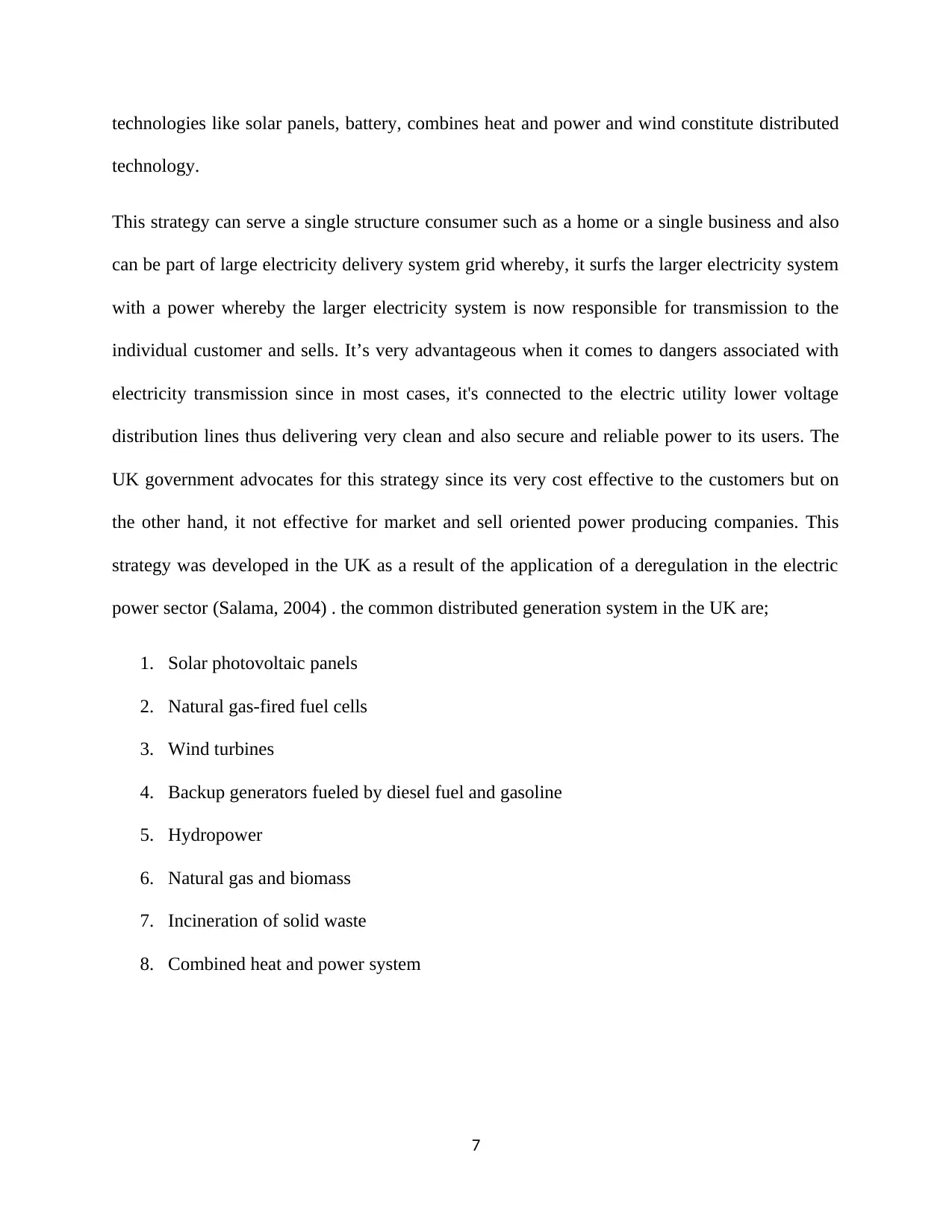
technologies like solar panels, battery, combines heat and power and wind constitute distributed
technology.
This strategy can serve a single structure consumer such as a home or a single business and also
can be part of large electricity delivery system grid whereby, it surfs the larger electricity system
with a power whereby the larger electricity system is now responsible for transmission to the
individual customer and sells. It’s very advantageous when it comes to dangers associated with
electricity transmission since in most cases, it's connected to the electric utility lower voltage
distribution lines thus delivering very clean and also secure and reliable power to its users. The
UK government advocates for this strategy since its very cost effective to the customers but on
the other hand, it not effective for market and sell oriented power producing companies. This
strategy was developed in the UK as a result of the application of a deregulation in the electric
power sector (Salama, 2004) . the common distributed generation system in the UK are;
1. Solar photovoltaic panels
2. Natural gas-fired fuel cells
3. Wind turbines
4. Backup generators fueled by diesel fuel and gasoline
5. Hydropower
6. Natural gas and biomass
7. Incineration of solid waste
8. Combined heat and power system
7
technology.
This strategy can serve a single structure consumer such as a home or a single business and also
can be part of large electricity delivery system grid whereby, it surfs the larger electricity system
with a power whereby the larger electricity system is now responsible for transmission to the
individual customer and sells. It’s very advantageous when it comes to dangers associated with
electricity transmission since in most cases, it's connected to the electric utility lower voltage
distribution lines thus delivering very clean and also secure and reliable power to its users. The
UK government advocates for this strategy since its very cost effective to the customers but on
the other hand, it not effective for market and sell oriented power producing companies. This
strategy was developed in the UK as a result of the application of a deregulation in the electric
power sector (Salama, 2004) . the common distributed generation system in the UK are;
1. Solar photovoltaic panels
2. Natural gas-fired fuel cells
3. Wind turbines
4. Backup generators fueled by diesel fuel and gasoline
5. Hydropower
6. Natural gas and biomass
7. Incineration of solid waste
8. Combined heat and power system
7
Paraphrase This Document
Need a fresh take? Get an instant paraphrase of this document with our AI Paraphraser
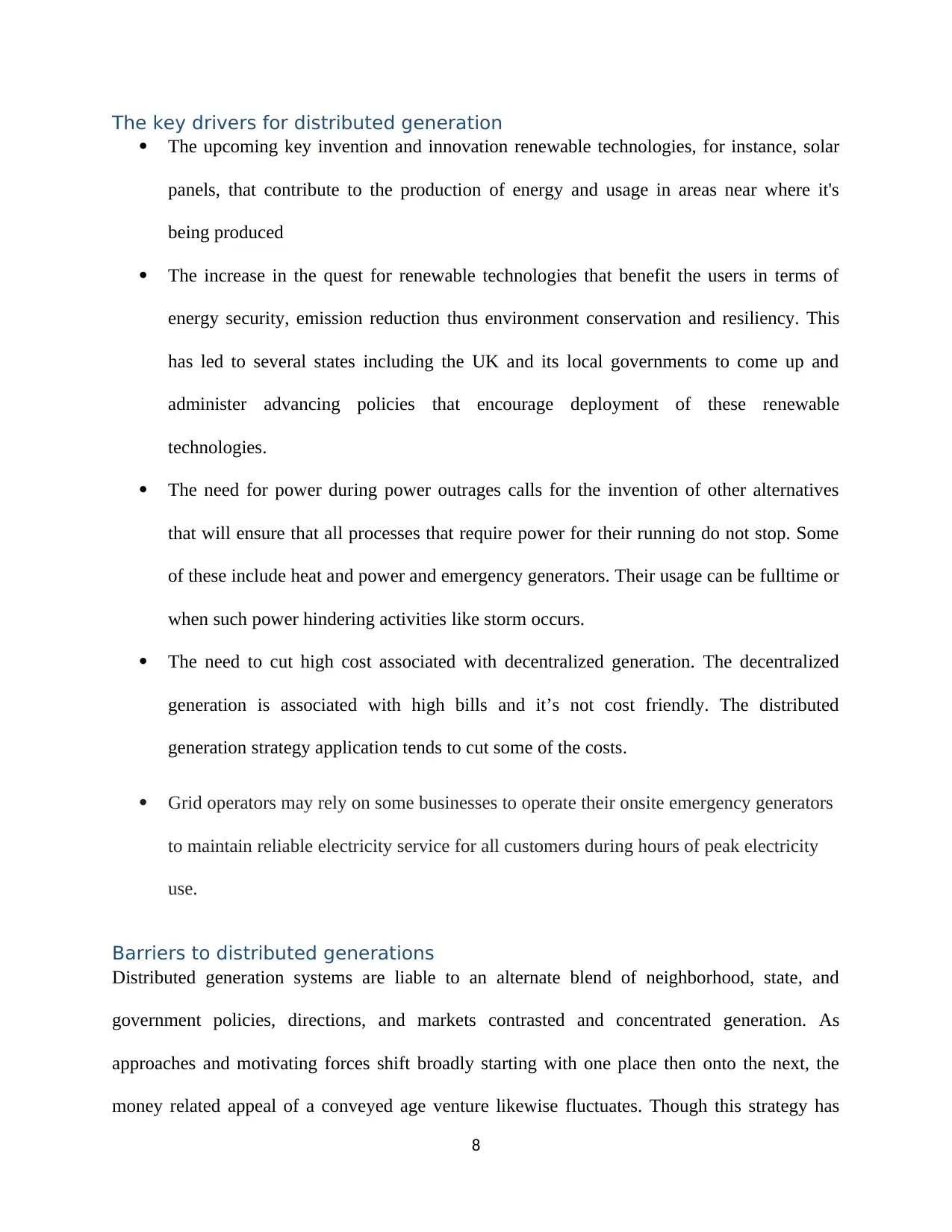
The key drivers for distributed generation
The upcoming key invention and innovation renewable technologies, for instance, solar
panels, that contribute to the production of energy and usage in areas near where it's
being produced
The increase in the quest for renewable technologies that benefit the users in terms of
energy security, emission reduction thus environment conservation and resiliency. This
has led to several states including the UK and its local governments to come up and
administer advancing policies that encourage deployment of these renewable
technologies.
The need for power during power outrages calls for the invention of other alternatives
that will ensure that all processes that require power for their running do not stop. Some
of these include heat and power and emergency generators. Their usage can be fulltime or
when such power hindering activities like storm occurs.
The need to cut high cost associated with decentralized generation. The decentralized
generation is associated with high bills and it’s not cost friendly. The distributed
generation strategy application tends to cut some of the costs.
Grid operators may rely on some businesses to operate their onsite emergency generators
to maintain reliable electricity service for all customers during hours of peak electricity
use.
Barriers to distributed generations
Distributed generation systems are liable to an alternate blend of neighborhood, state, and
government policies, directions, and markets contrasted and concentrated generation. As
approaches and motivating forces shift broadly starting with one place then onto the next, the
money related appeal of a conveyed age venture likewise fluctuates. Though this strategy has
8
The upcoming key invention and innovation renewable technologies, for instance, solar
panels, that contribute to the production of energy and usage in areas near where it's
being produced
The increase in the quest for renewable technologies that benefit the users in terms of
energy security, emission reduction thus environment conservation and resiliency. This
has led to several states including the UK and its local governments to come up and
administer advancing policies that encourage deployment of these renewable
technologies.
The need for power during power outrages calls for the invention of other alternatives
that will ensure that all processes that require power for their running do not stop. Some
of these include heat and power and emergency generators. Their usage can be fulltime or
when such power hindering activities like storm occurs.
The need to cut high cost associated with decentralized generation. The decentralized
generation is associated with high bills and it’s not cost friendly. The distributed
generation strategy application tends to cut some of the costs.
Grid operators may rely on some businesses to operate their onsite emergency generators
to maintain reliable electricity service for all customers during hours of peak electricity
use.
Barriers to distributed generations
Distributed generation systems are liable to an alternate blend of neighborhood, state, and
government policies, directions, and markets contrasted and concentrated generation. As
approaches and motivating forces shift broadly starting with one place then onto the next, the
money related appeal of a conveyed age venture likewise fluctuates. Though this strategy has
8
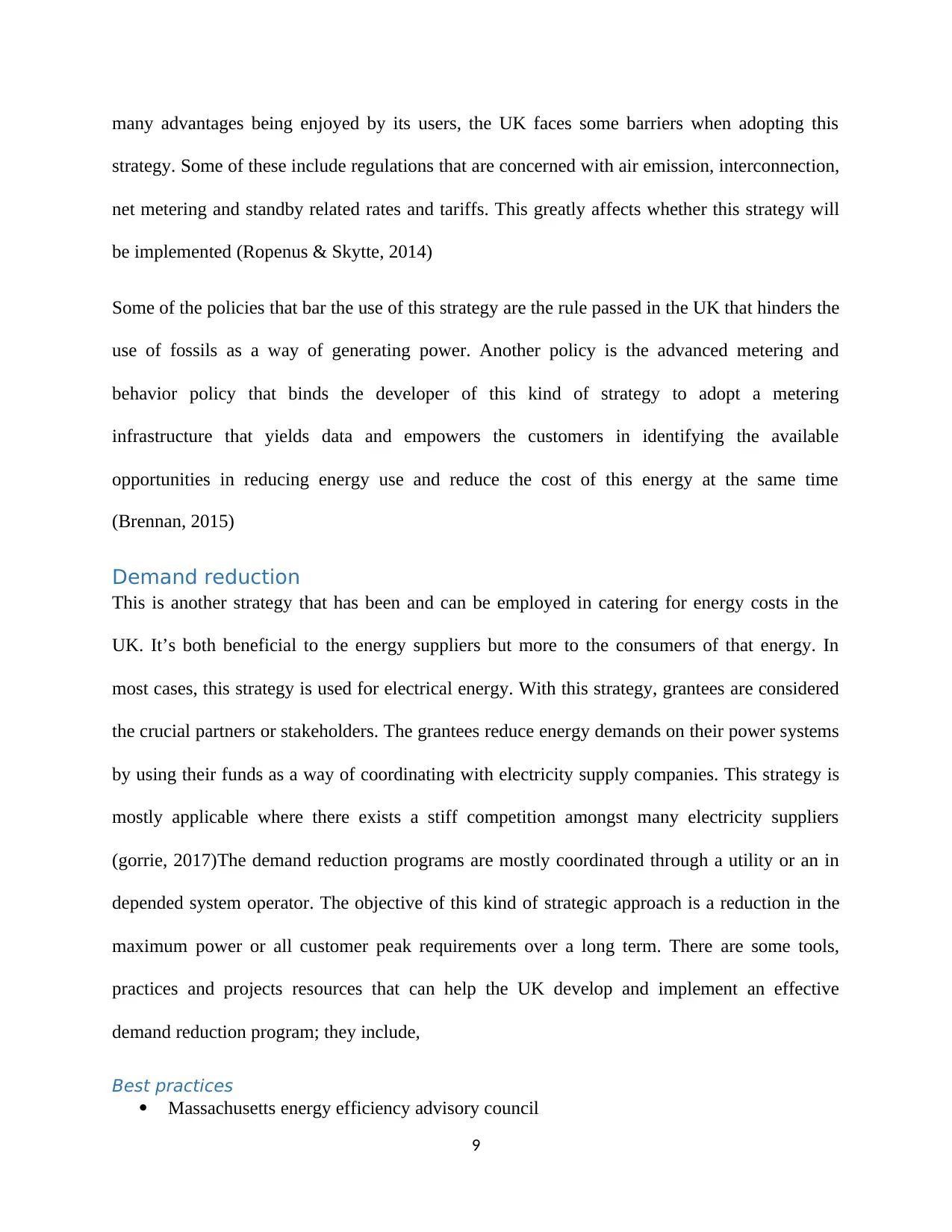
many advantages being enjoyed by its users, the UK faces some barriers when adopting this
strategy. Some of these include regulations that are concerned with air emission, interconnection,
net metering and standby related rates and tariffs. This greatly affects whether this strategy will
be implemented (Ropenus & Skytte, 2014)
Some of the policies that bar the use of this strategy are the rule passed in the UK that hinders the
use of fossils as a way of generating power. Another policy is the advanced metering and
behavior policy that binds the developer of this kind of strategy to adopt a metering
infrastructure that yields data and empowers the customers in identifying the available
opportunities in reducing energy use and reduce the cost of this energy at the same time
(Brennan, 2015)
Demand reduction
This is another strategy that has been and can be employed in catering for energy costs in the
UK. It’s both beneficial to the energy suppliers but more to the consumers of that energy. In
most cases, this strategy is used for electrical energy. With this strategy, grantees are considered
the crucial partners or stakeholders. The grantees reduce energy demands on their power systems
by using their funds as a way of coordinating with electricity supply companies. This strategy is
mostly applicable where there exists a stiff competition amongst many electricity suppliers
(gorrie, 2017)The demand reduction programs are mostly coordinated through a utility or an in
depended system operator. The objective of this kind of strategic approach is a reduction in the
maximum power or all customer peak requirements over a long term. There are some tools,
practices and projects resources that can help the UK develop and implement an effective
demand reduction program; they include,
Best practices
Massachusetts energy efficiency advisory council
9
strategy. Some of these include regulations that are concerned with air emission, interconnection,
net metering and standby related rates and tariffs. This greatly affects whether this strategy will
be implemented (Ropenus & Skytte, 2014)
Some of the policies that bar the use of this strategy are the rule passed in the UK that hinders the
use of fossils as a way of generating power. Another policy is the advanced metering and
behavior policy that binds the developer of this kind of strategy to adopt a metering
infrastructure that yields data and empowers the customers in identifying the available
opportunities in reducing energy use and reduce the cost of this energy at the same time
(Brennan, 2015)
Demand reduction
This is another strategy that has been and can be employed in catering for energy costs in the
UK. It’s both beneficial to the energy suppliers but more to the consumers of that energy. In
most cases, this strategy is used for electrical energy. With this strategy, grantees are considered
the crucial partners or stakeholders. The grantees reduce energy demands on their power systems
by using their funds as a way of coordinating with electricity supply companies. This strategy is
mostly applicable where there exists a stiff competition amongst many electricity suppliers
(gorrie, 2017)The demand reduction programs are mostly coordinated through a utility or an in
depended system operator. The objective of this kind of strategic approach is a reduction in the
maximum power or all customer peak requirements over a long term. There are some tools,
practices and projects resources that can help the UK develop and implement an effective
demand reduction program; they include,
Best practices
Massachusetts energy efficiency advisory council
9
⊘ This is a preview!⊘
Do you want full access?
Subscribe today to unlock all pages.

Trusted by 1+ million students worldwide
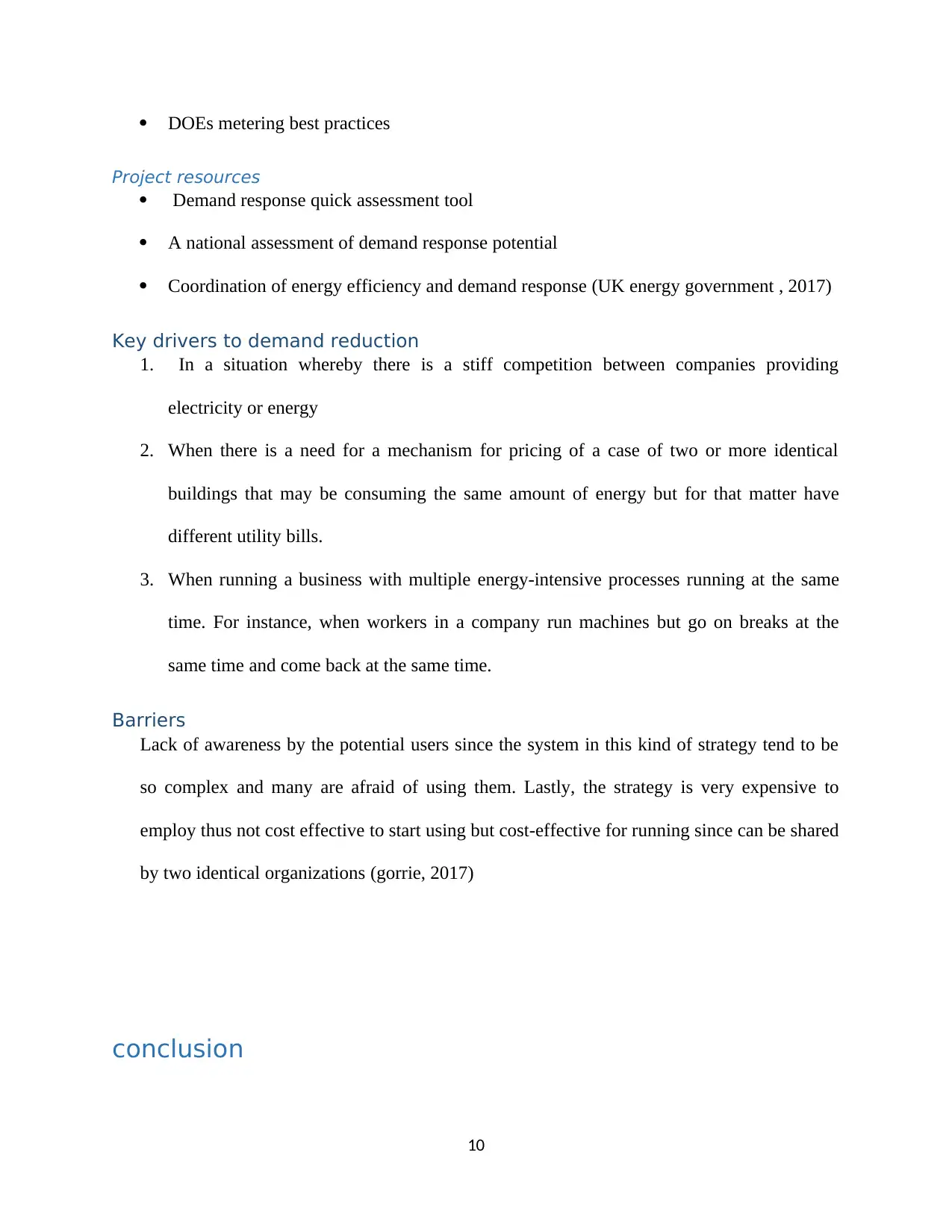
DOEs metering best practices
Project resources
Demand response quick assessment tool
A national assessment of demand response potential
Coordination of energy efficiency and demand response (UK energy government , 2017)
Key drivers to demand reduction
1. In a situation whereby there is a stiff competition between companies providing
electricity or energy
2. When there is a need for a mechanism for pricing of a case of two or more identical
buildings that may be consuming the same amount of energy but for that matter have
different utility bills.
3. When running a business with multiple energy-intensive processes running at the same
time. For instance, when workers in a company run machines but go on breaks at the
same time and come back at the same time.
Barriers
Lack of awareness by the potential users since the system in this kind of strategy tend to be
so complex and many are afraid of using them. Lastly, the strategy is very expensive to
employ thus not cost effective to start using but cost-effective for running since can be shared
by two identical organizations (gorrie, 2017)
conclusion
10
Project resources
Demand response quick assessment tool
A national assessment of demand response potential
Coordination of energy efficiency and demand response (UK energy government , 2017)
Key drivers to demand reduction
1. In a situation whereby there is a stiff competition between companies providing
electricity or energy
2. When there is a need for a mechanism for pricing of a case of two or more identical
buildings that may be consuming the same amount of energy but for that matter have
different utility bills.
3. When running a business with multiple energy-intensive processes running at the same
time. For instance, when workers in a company run machines but go on breaks at the
same time and come back at the same time.
Barriers
Lack of awareness by the potential users since the system in this kind of strategy tend to be
so complex and many are afraid of using them. Lastly, the strategy is very expensive to
employ thus not cost effective to start using but cost-effective for running since can be shared
by two identical organizations (gorrie, 2017)
conclusion
10
Paraphrase This Document
Need a fresh take? Get an instant paraphrase of this document with our AI Paraphraser
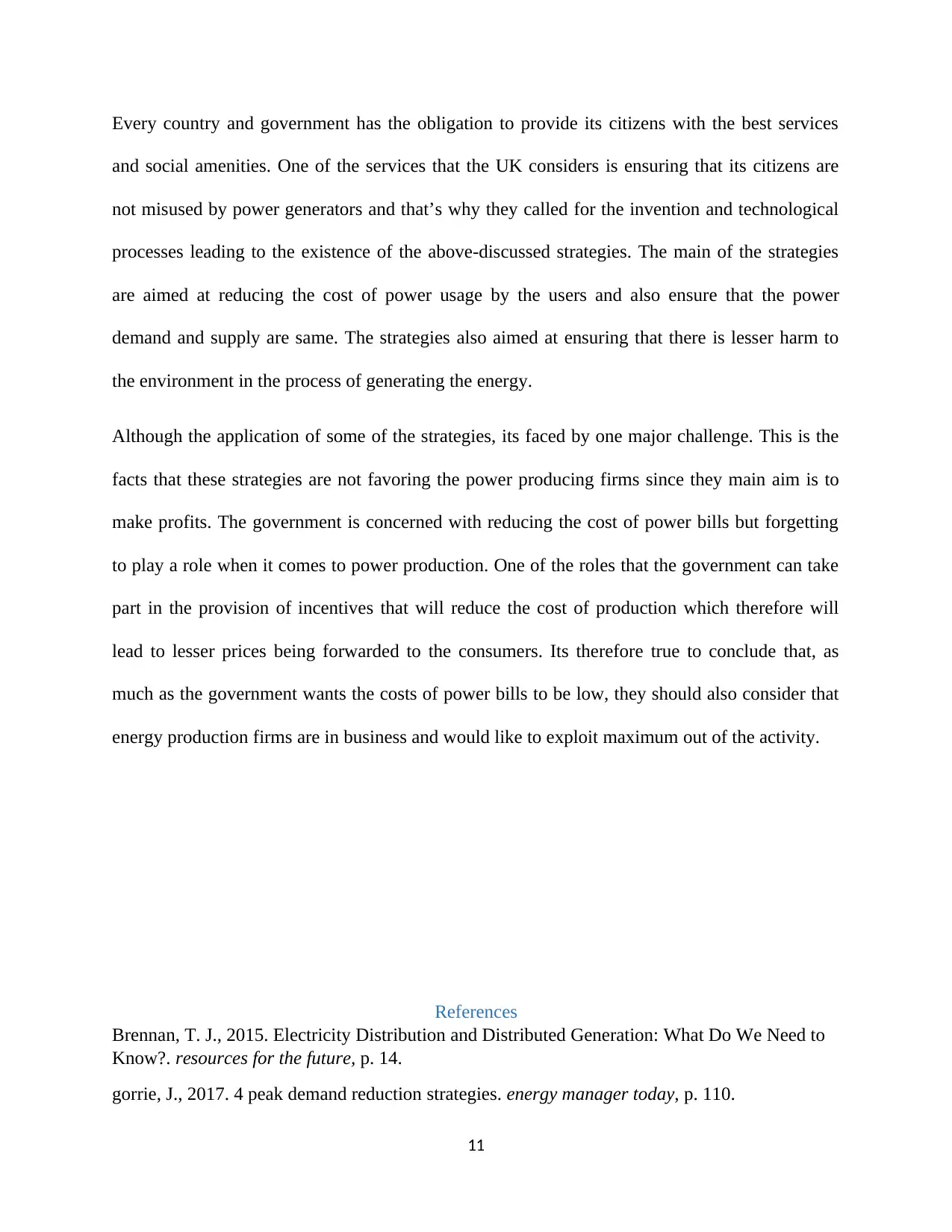
Every country and government has the obligation to provide its citizens with the best services
and social amenities. One of the services that the UK considers is ensuring that its citizens are
not misused by power generators and that’s why they called for the invention and technological
processes leading to the existence of the above-discussed strategies. The main of the strategies
are aimed at reducing the cost of power usage by the users and also ensure that the power
demand and supply are same. The strategies also aimed at ensuring that there is lesser harm to
the environment in the process of generating the energy.
Although the application of some of the strategies, its faced by one major challenge. This is the
facts that these strategies are not favoring the power producing firms since they main aim is to
make profits. The government is concerned with reducing the cost of power bills but forgetting
to play a role when it comes to power production. One of the roles that the government can take
part in the provision of incentives that will reduce the cost of production which therefore will
lead to lesser prices being forwarded to the consumers. Its therefore true to conclude that, as
much as the government wants the costs of power bills to be low, they should also consider that
energy production firms are in business and would like to exploit maximum out of the activity.
References
Brennan, T. J., 2015. Electricity Distribution and Distributed Generation: What Do We Need to
Know?. resources for the future, p. 14.
gorrie, J., 2017. 4 peak demand reduction strategies. energy manager today, p. 110.
11
and social amenities. One of the services that the UK considers is ensuring that its citizens are
not misused by power generators and that’s why they called for the invention and technological
processes leading to the existence of the above-discussed strategies. The main of the strategies
are aimed at reducing the cost of power usage by the users and also ensure that the power
demand and supply are same. The strategies also aimed at ensuring that there is lesser harm to
the environment in the process of generating the energy.
Although the application of some of the strategies, its faced by one major challenge. This is the
facts that these strategies are not favoring the power producing firms since they main aim is to
make profits. The government is concerned with reducing the cost of power bills but forgetting
to play a role when it comes to power production. One of the roles that the government can take
part in the provision of incentives that will reduce the cost of production which therefore will
lead to lesser prices being forwarded to the consumers. Its therefore true to conclude that, as
much as the government wants the costs of power bills to be low, they should also consider that
energy production firms are in business and would like to exploit maximum out of the activity.
References
Brennan, T. J., 2015. Electricity Distribution and Distributed Generation: What Do We Need to
Know?. resources for the future, p. 14.
gorrie, J., 2017. 4 peak demand reduction strategies. energy manager today, p. 110.
11
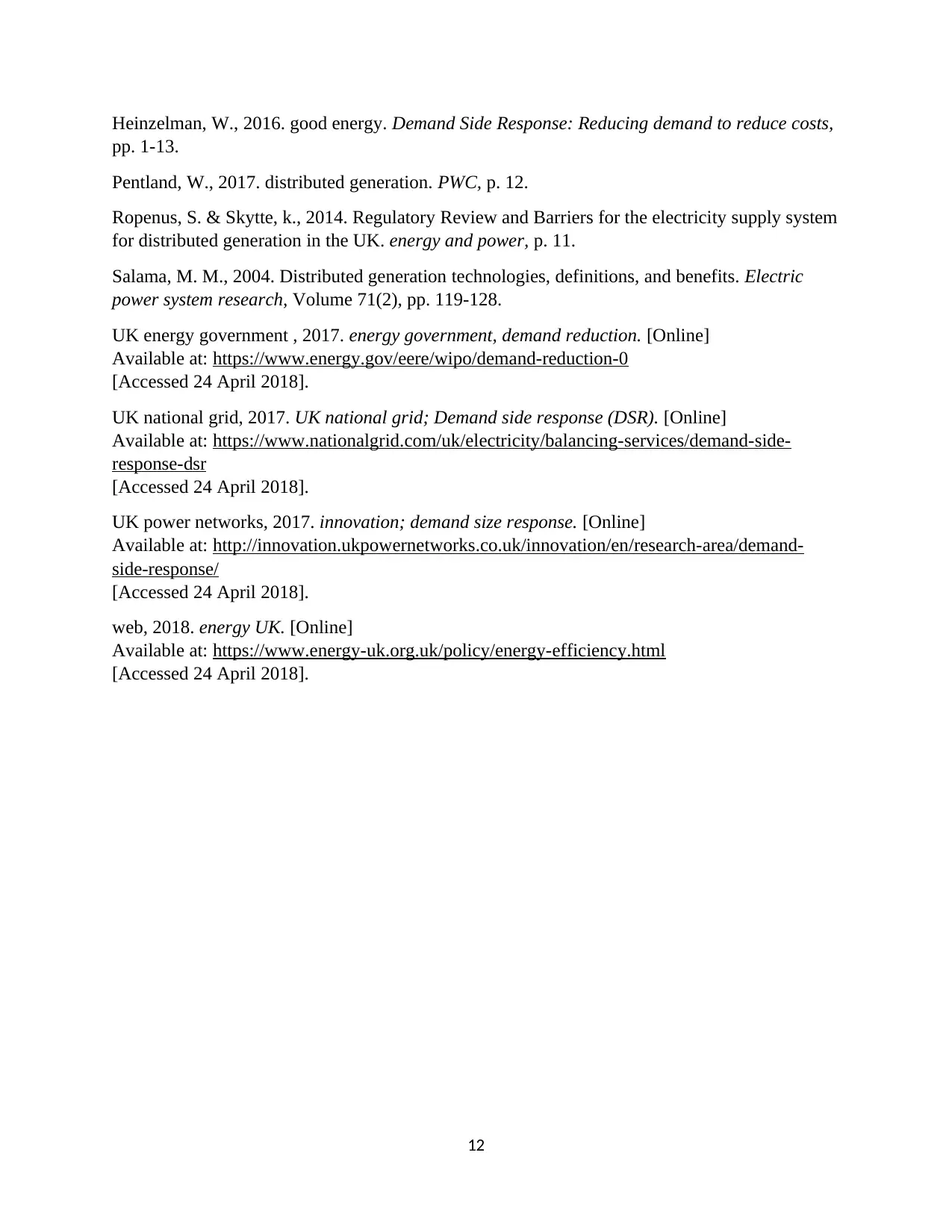
Heinzelman, W., 2016. good energy. Demand Side Response: Reducing demand to reduce costs,
pp. 1-13.
Pentland, W., 2017. distributed generation. PWC, p. 12.
Ropenus, S. & Skytte, k., 2014. Regulatory Review and Barriers for the electricity supply system
for distributed generation in the UK. energy and power, p. 11.
Salama, M. M., 2004. Distributed generation technologies, definitions, and benefits. Electric
power system research, Volume 71(2), pp. 119-128.
UK energy government , 2017. energy government, demand reduction. [Online]
Available at: https://www.energy.gov/eere/wipo/demand-reduction-0
[Accessed 24 April 2018].
UK national grid, 2017. UK national grid; Demand side response (DSR). [Online]
Available at: https://www.nationalgrid.com/uk/electricity/balancing-services/demand-side-
response-dsr
[Accessed 24 April 2018].
UK power networks, 2017. innovation; demand size response. [Online]
Available at: http://innovation.ukpowernetworks.co.uk/innovation/en/research-area/demand-
side-response/
[Accessed 24 April 2018].
web, 2018. energy UK. [Online]
Available at: https://www.energy-uk.org.uk/policy/energy-efficiency.html
[Accessed 24 April 2018].
12
pp. 1-13.
Pentland, W., 2017. distributed generation. PWC, p. 12.
Ropenus, S. & Skytte, k., 2014. Regulatory Review and Barriers for the electricity supply system
for distributed generation in the UK. energy and power, p. 11.
Salama, M. M., 2004. Distributed generation technologies, definitions, and benefits. Electric
power system research, Volume 71(2), pp. 119-128.
UK energy government , 2017. energy government, demand reduction. [Online]
Available at: https://www.energy.gov/eere/wipo/demand-reduction-0
[Accessed 24 April 2018].
UK national grid, 2017. UK national grid; Demand side response (DSR). [Online]
Available at: https://www.nationalgrid.com/uk/electricity/balancing-services/demand-side-
response-dsr
[Accessed 24 April 2018].
UK power networks, 2017. innovation; demand size response. [Online]
Available at: http://innovation.ukpowernetworks.co.uk/innovation/en/research-area/demand-
side-response/
[Accessed 24 April 2018].
web, 2018. energy UK. [Online]
Available at: https://www.energy-uk.org.uk/policy/energy-efficiency.html
[Accessed 24 April 2018].
12
⊘ This is a preview!⊘
Do you want full access?
Subscribe today to unlock all pages.

Trusted by 1+ million students worldwide
1 out of 12
Related Documents
Your All-in-One AI-Powered Toolkit for Academic Success.
+13062052269
info@desklib.com
Available 24*7 on WhatsApp / Email
![[object Object]](/_next/static/media/star-bottom.7253800d.svg)
Unlock your academic potential
Copyright © 2020–2025 A2Z Services. All Rights Reserved. Developed and managed by ZUCOL.





